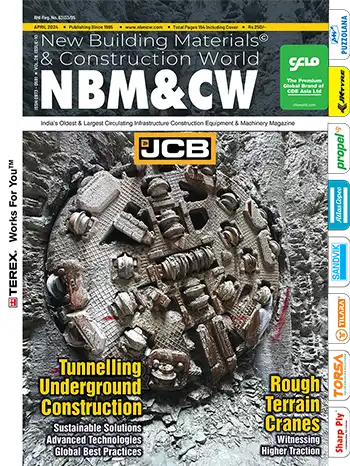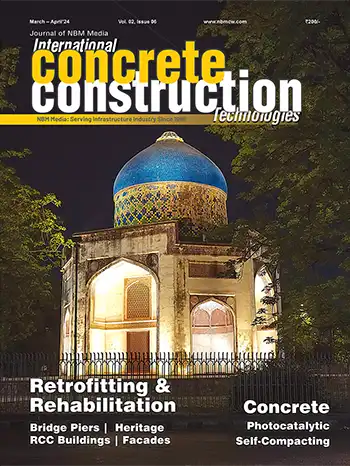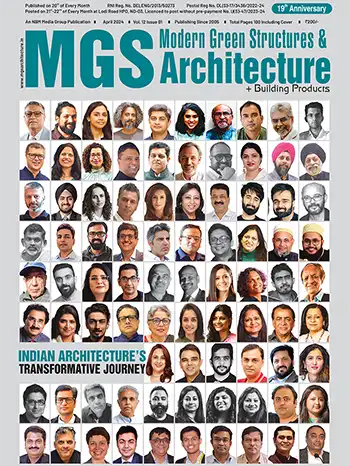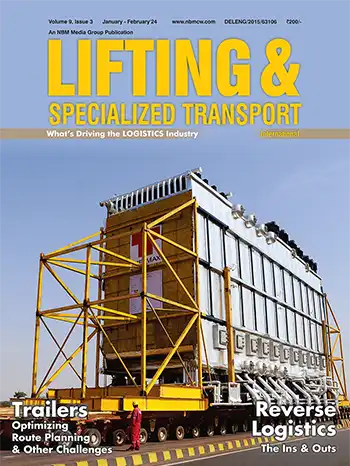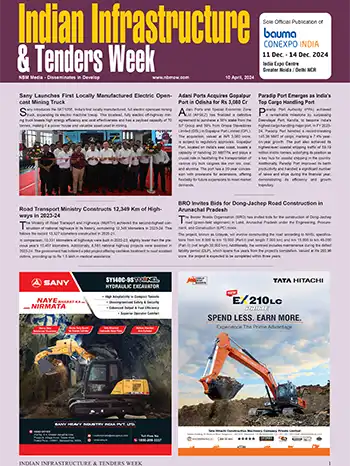Green, Sustainable Construction: Solutions for Affordable Housing
Sunny Surlaker, Director, Samir Surlaker, Director, Institute for International Talent Development, Paresh Unnarkar, RCC Consultant, Unnarkar’s Green Concrete Technology (UGCT)
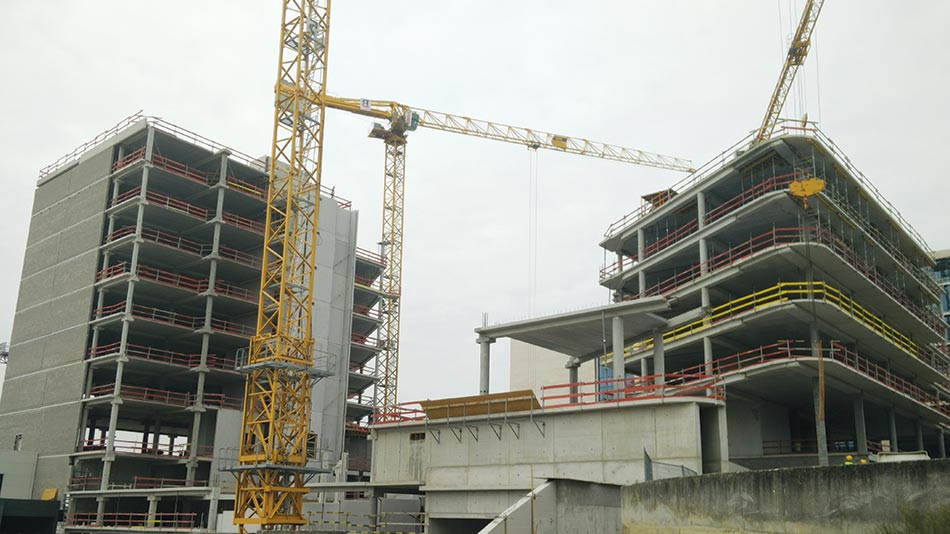
Concrete is the second most consumed material in the world after water and it is used most widely in the construction industry due to its high compressive strength and other properties.[1] Therefore, the basis of sustainable construction should be concrete using a lower amount of cement, more recycled materials, more supplementary cementitious materials and new generation ingredients to reduce water ingress and deterioration in concrete. This will ensure that the construction is sustainable and at the same time will be economical by reducing the associated repair, maintenance materials and cost.
We all are aware that, to produce 1 Ton of Ordinary Portland Cement approximately 1 Ton of Carbon dioxide is emitted in the environment. India is the second largest producer of cement after China. From this, we can gauge how much Carbon dioxide is emitted and carbon footprint is increasing. A need was identified to develop a construction system, which was green (lower carbon footprint as opposed to regular concrete), provided energy savings over life of the structure, had improved durability and had to match cost economics and capital expenditure for constructing the structure. This paper describes the concept in detail, which uses a combination of Green Concrete, Aluminium Slip Formwork System (e.g. MIVAN Shuttering) and use of a thermal barrier coating system as insulative and waterproof coating to deliver a structure that can be built more durably, more sustainably and cheaper than a conventional structure. This combination has been specified on an upcoming PM Awas Yojana (PMAY) Project in the Vasai – Virar region.
The Concept
The concept developed was to develop a construction system that would reduce both environmental and financial impact over the lifecycle of the structure from start to demolition. The concept was further developed to use the best materials and Construction Systems Possible.
Green Concrete Technology
To make Concrete green, sustainable and durable a new mix design methodology was considered, that helps optimize the OPC used in concrete by replacing 50% of the OPC content by GGBFS. Our associates, at Unnarkar’s Green Concrete Technology, Virar, decided to produce concrete that would be “Ecological, Economical, Workable & Durable”.
This paper would discuss three aspects of the Green Concrete Technology:
To compare properties, concretes with 5 different binder proportions were tested. These included:
The mix designs used for the evaluation are given in Table 1 and the results in Table 2: In summary, the results indicated that despite replacing 50% of the OPC with GGBFS, the results of tests for:
The Green Concrete Concept was therefore deemed successful and taken up for use at 2 Construction Sites in Virar.
Practical Usage of Green Concrete at 2 Construction Sites in Virar
The application of Green Concrete was then practically achieved on 2 local construction sites, employing site batched concrete manufactured in a 0.5 cum capacity automated batching plant. The projects were Paradise Park and Narayan Industrial Complex. The mix design (for M30 grade of Concrete) utilized for the site was as shown in Table 3:
The mix showed consistent cube strength of average 42 N / mm2 at 56 days, which was validated by means of cores cut from various parts of the structure. The amount of OPC replaced was in excess of 2000 metric tons, reducing the carbon footprint of the building greatly. The building structure was thus completed sustainably, reliably and more economically (savings of more than ₹30 / bag of cement).
Mix Design Procedure for Green SCC to be used in the upcoming PMAY Project.
The success of using Green Concrete at 2 project sites, further spawned the idea, which led to the concept of development of a Self Compacting Concrete, with a grade of M45, which was to be placed in Aluminium Wall Shuttering for a low cost mass housing (PMAY) project. The SCC mix was developed using the particle packing method based on Modified Andreassen’s Theory for particle packing. The mix incorporated locally available 12.5mm down coarse aggregate, locally available crushed and manufactured sand, Ultratech OPC (53 grade), locally sourced GGBFS, locally sourced hydrated lime and the latest generation (PCE based) hyperplasticizers.
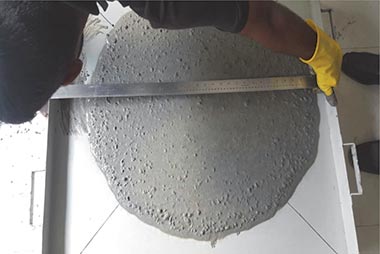 Figure 1: Visual of SCC Mix Design during Flow Test
The aim was to develop a SCC mix, that could be placed rapidly and reliably in aluminium forms, to improve speed of construction and eliminate brick / blockwork and thereby reduce costs of construction. In addition, the concrete mix was to incorporate minimal OPC content to reduce costs and improve durability parameters of the concrete. This form of construction would help eliminate joints and therefore leakage problems in the housing units, thereby increasing durability. The low cost of time, labour and materials would ensure the low-cost mass housing units would be built rapidly, durably and sustainably. The mix design evaluated is given in Table 4 and the results of various tests performed are given in Table 5. A view of the concrete itself is given in Figure 1.
Figure 1: Visual of SCC Mix Design during Flow Test
The aim was to develop a SCC mix, that could be placed rapidly and reliably in aluminium forms, to improve speed of construction and eliminate brick / blockwork and thereby reduce costs of construction. In addition, the concrete mix was to incorporate minimal OPC content to reduce costs and improve durability parameters of the concrete. This form of construction would help eliminate joints and therefore leakage problems in the housing units, thereby increasing durability. The low cost of time, labour and materials would ensure the low-cost mass housing units would be built rapidly, durably and sustainably. The mix design evaluated is given in Table 4 and the results of various tests performed are given in Table 5. A view of the concrete itself is given in Figure 1.
The mix was further re-tested successfully to ensure repeatability and consistency of results.
Aluminium Slip-Form System
This particular formwork was chosen for the PMAY Project concept to hasten the construction process, reduce formwork requirement over the duration of the project and to provide a monolithic durable structure. Some of the salient features this system provides are:
To supplement the Green Concrete Building Concept with SCC, it was decided to coat the aluminium formwork wall system structure with a Thermal Barrier Coating System. This coating, in addition to providing insulation (energy reduction of over 25%), would provide a waterproof barrier and aesthetic finish to the green concrete building.
This Thermal Barrier Coating is a specially formulated solar radiation and heat resisting, one component acrylic co-polymer based surface coating incorporating selected microscopic hollow ceramic spheres. The coating works as a thermal barrier, by reflecting, refracting and dissipating radiant heat.
Incident Heat is Composed of UV Heat [about 3%], Visible Heat [about 44%] and Infrared Heat [about 53%]. This heat on a substrate is transferred through the substrate into the living / occupied spaces by means of conduction [through the substrate], convection [heating of air below substrate] and by radiation [back to the atmosphere].
Working Mechanism
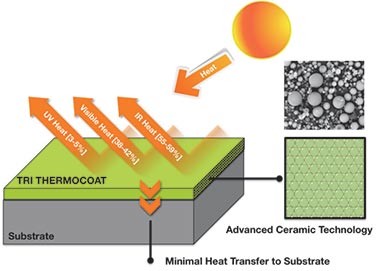 Figure 2: Working Mechanism of Thermal Barrier Coating
The coating is composed of advanced hollow ceramic microspheres, heat resisting fillers and special pigments, bound in a special acrylic co-polymer matrix enhanced to minimize heat transmission through the coating. Applied as a thin layer [0.7 to 1 mm thick], the coating behaves like insulation on any substrate it is applied to. Due to the Ceramic Microspheres, the heat is partly reflected, partly dissipated and a very small amount is lost by convection through the coating. This mechanism is shown in Figure 2.
Figure 2: Working Mechanism of Thermal Barrier Coating
The coating is composed of advanced hollow ceramic microspheres, heat resisting fillers and special pigments, bound in a special acrylic co-polymer matrix enhanced to minimize heat transmission through the coating. Applied as a thin layer [0.7 to 1 mm thick], the coating behaves like insulation on any substrate it is applied to. Due to the Ceramic Microspheres, the heat is partly reflected, partly dissipated and a very small amount is lost by convection through the coating. This mechanism is shown in Figure 2.
This is the guiding principle in the design of the coating and allows minimal amount of heat to transfer to the substrate, keeping it cool and the environment in the living / occupied spaces also cool. Since it can keep the substrate and air around it cooler, lesser energy is required to heat or cool the area, leading to tremendous energy savings [Heating or AC].
The material can be used as an intermediate primer, protective topcoat or replacement for a complete insulating system. The coating exhibits excellent test values for R Value, Emittance, and Solar reflectance and is an effective means of lowering solar heat gains in a structure. It adds to sustainability of a structure, by reducing heat gains, increasing cooling efficiency and reducing energy consumption and cooling costs.
The unique feature of this thermal barrier coating, versus others available in the market today is that it has a low specific gravity (~ 0.65), but a very high solid content [> 80% by volume]. This lends unique thermal properties to the coating. The product is water based and thus sustainable with low VOC content and gives off no fumes when applied externally or internally. The presence of a ceramic and special fillers ensure the coating is strong, resistance to foot traffic after application and is totally waterproof. The special acrylic binder ensures the coating is resistant to carbonation, chlorides and salts as well, so that the coating and the protected substrate is ensured of long term durability. Some of the other features of this type of thermal barrier coating are shown in Figure 3.
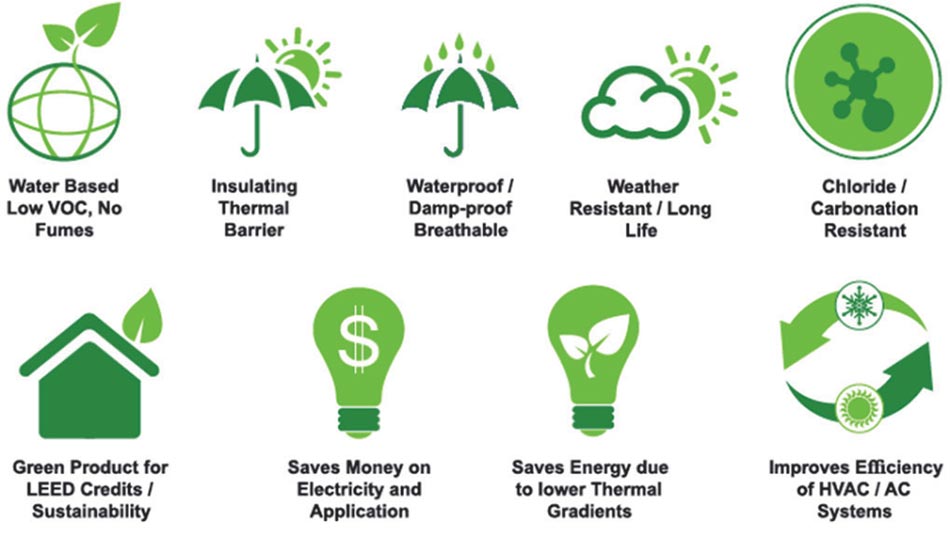 Figure 3: Features of Thermal Barrier Coating
Figure 3: Features of Thermal Barrier Coating
Advantages of using a Thermal Barrier Coating
COATED ROOM . . . . . . . . . . . .129 KWH
UNCOATED ROOM. . . . . . . . . .202 KWH
Figures above indicate a 36.1% reduction in electricity usage for the air conditioner in the coated room as opposed to the usage in the control room. It bears noting that this facility already had a light colored roof coating. Application of this material to dark roofs or the underside of roof decking with dark shingles may produce even more dramatic results.

Cost Analysis
The concept discussed above using Green SCC, Aluminium Slip-Form System and Thermal Coating is proposed and specified to be used for a PM Awas Yojana Project, Padgha. The Block Plan for the project is shown in Figure 4. Phase 1 of the building comprises of 170 such units. The Basic Project details are given in Table 6.
Following this the cost was compared for Conventional RCC Structure including Plaster and Paint Finishing and RCC Structure using Green Concrete, Aluminium Formwork and Thermal Barrier Coating. The items considered under each type of construction are given in Table 7.
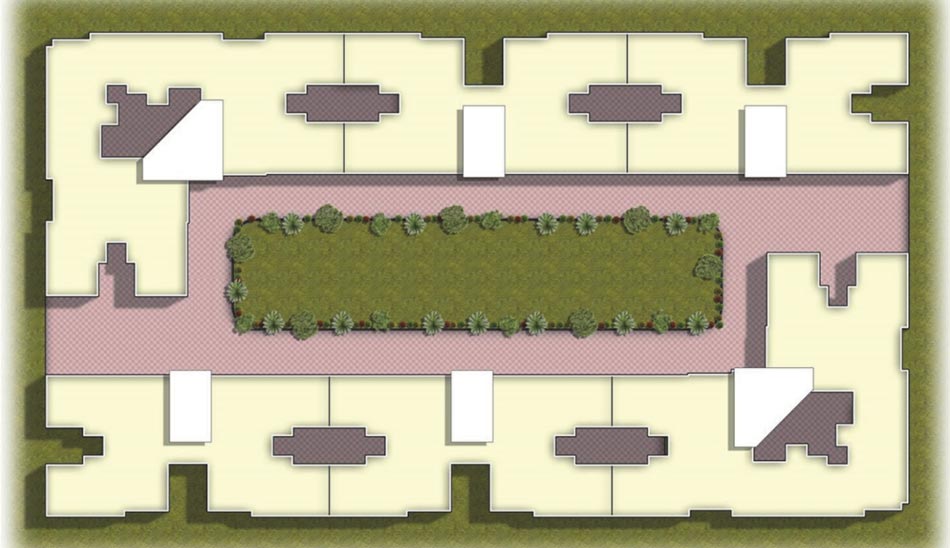 Figure 4: Plan for a single Block at the PMAY Project, Padgha
Figure 4: Plan for a single Block at the PMAY Project, Padgha
Once the unit rates were entered for the items in Table 7, for 1 building of 28,125 sq. ft. the capital cost per sq.ft. for the conventional structure amounted to ₹681/- per sq. ft. Comparatively the cost per sq. ft. amounted to ₹659/- per sq.ft. for the SCC, Aluminium Formwork System and Thermal Barrier Coating Concept. This amounts to a saving of ₹22/- per sq.ft. and considering the cost of 1 building, a saving of ₹6,18,750/-. Over the 1st phase of the project (170 buildings) the savings would amount to ₹10,51,87,500/- (10.52 crores).
Thus the advanced system of construction, would actually end up being cheaper than the conventional method of construction, not to mention, being faster. The use of the Thermal Barrier Coating would provide water-tightness, durability and most importantly energy saving and cost saving (almost 25%) over the occupational life of the structure. In brief using the Green Concrete, Aluminium Formwork and Thermal Barrier Concept would have the following advantages:
Mass housing is going to be the biggest concern for India as we are rapidly progressing into urbanization. The combination of green concrete with a high percentage replacement of OPC in combination a thermal barrier coating external building envelope, can help reduce carbon footprint during the construction phase of the building as well as during the in-service life of the building.
The use of Green Concrete helps both environmental sustainability as well as the durability concerns in concrete. These low OPC mixes can be designed to meet high strength parameters (> 50 N/mm2) as well as workability requirements (we designed SCC) as depicted by the case-studies in the paper. This concrete can be used in the construction of aluminium formwork wall systems, which can quicken the pace of construction, lower labour and material costs and provide the high durability required.
These form-walled buildings can be coated externally with a thermal barrier coating, which will provide true insulation, a waterproof barrier and an aesthetically pleasing coating. This easy to apply system, helps saves energy (cooling air conditioning cost, or heating) by over 25%. This directly benefits the residents in terms of lower energy bills and better durability over the usable life of the structure.
This combination can be the new standard in providing both low environmental impact, energy saving, green buildings, that are cheaper to build and maintain and can save money over the life-cycle of the structure. This lends great value to creating truly low cost mass housing, that will be cost efficient over the entire life-cycle of the structure.
References:

Concrete is the second most consumed material in the world after water and it is used most widely in the construction industry due to its high compressive strength and other properties.[1] Therefore, the basis of sustainable construction should be concrete using a lower amount of cement, more recycled materials, more supplementary cementitious materials and new generation ingredients to reduce water ingress and deterioration in concrete. This will ensure that the construction is sustainable and at the same time will be economical by reducing the associated repair, maintenance materials and cost.
We all are aware that, to produce 1 Ton of Ordinary Portland Cement approximately 1 Ton of Carbon dioxide is emitted in the environment. India is the second largest producer of cement after China. From this, we can gauge how much Carbon dioxide is emitted and carbon footprint is increasing. A need was identified to develop a construction system, which was green (lower carbon footprint as opposed to regular concrete), provided energy savings over life of the structure, had improved durability and had to match cost economics and capital expenditure for constructing the structure. This paper describes the concept in detail, which uses a combination of Green Concrete, Aluminium Slip Formwork System (e.g. MIVAN Shuttering) and use of a thermal barrier coating system as insulative and waterproof coating to deliver a structure that can be built more durably, more sustainably and cheaper than a conventional structure. This combination has been specified on an upcoming PM Awas Yojana (PMAY) Project in the Vasai – Virar region.
The Concept
The concept developed was to develop a construction system that would reduce both environmental and financial impact over the lifecycle of the structure from start to demolition. The concept was further developed to use the best materials and Construction Systems Possible.
- Green Self-Compacting Concrete (utilizing ~ 50% GGBFS and PCE Admixtures)
- Aluminium Slip-Form Work system
- Advanced Thermal Barrier Coating to Provide for Insulation (Energy Savings), water-tightness (durability) and Aesthetics.
Green Concrete Technology
To make Concrete green, sustainable and durable a new mix design methodology was considered, that helps optimize the OPC used in concrete by replacing 50% of the OPC content by GGBFS. Our associates, at Unnarkar’s Green Concrete Technology, Virar, decided to produce concrete that would be “Ecological, Economical, Workable & Durable”.
This paper would discuss three aspects of the Green Concrete Technology:
- Detailed Laboratory Testing of Green Concrete (Regular)
- Practical Usage of Green Concrete at 2 Construction Sites in Virar
- Mix Design Procedure for Green SCC to be used in the upcoming PMAY Project.
To compare properties, concretes with 5 different binder proportions were tested. These included:
- Ordinary Portland Cement – 100%
- Portland Pozzolona Cement – 100%
- OPC (75%) + Fly Ash (25%)
- OPC (50%) + GGBFS (50%)
- OPC (90%) + Silica Fume (10%)
- Workability (Slump)
- Strength
- Durability: RCPT, Water Penetration Test & Water Permeability Test
| Table 1: Mix Designs Evaluated | ||||||||
| Type of Material | Source | Sp. Gravity | Absorption | Mix Proportions (kg/cum) | ||||
| 100% OPC | 100% PPC | OPC + Flyash | OPC +GGBS | OPC + SF | ||||
| OPC- 53 | Ultratech | 3.15 | 390 | 300 | 195 | 350 | ||
| PPC | Ultratech | 2.92 | 390 | |||||
| Flyash | Pozzoash | 2.20 | 90 | |||||
| GGBFS | Local | 3.04 | 195 | |||||
| Silica Fume | Elkem | 2.25 | 40 | |||||
| Natural Sand | Local | 2.65 | 3.74 | 714 | 703 | 701 | 711 | 708 |
| 10 mm | Local | 2.84 | 1.55 | 466 | 409 | 457 | 464 | 462 |
| 20 mm | Local | 2.85 | 1.29 | 618 | 609 | 607 | 616 | 614 |
| Water | Local | 1.00 | 233 | 233 | 233 | 233 | 233 | |
The mix designs used for the evaluation are given in Table 1 and the results in Table 2: In summary, the results indicated that despite replacing 50% of the OPC with GGBFS, the results of tests for:
- Workability: Were better as compared to other mixes
- Compressive Strengths: Were a little lower than OPC and SF mixes, but comparable to others
- Water Absorption: Were comparable to other mixes
- Water Permeability: Was a little more as compared to OPC and SF mixes, but comparable to others
- The RCPT Values: Coulombs Passed were a bit higher than the SF mix, but vastly better as compared to OPC, PPC and OPC + FA mixes
- Costs: For the OPC+GGBFS Concrete was ₹3838 / cum against ₹4290/cum for 100% OPC concrete. Therefore, the Savings using Green Concrete amounted to ₹452 / cum
| Table 2: Summary of results | |||||
| Test | Mix Proportions (kg/cum) | ||||
| 100% OPC | 100% PPC | OPC + Flyash | OPC +GGBS | OPC + SF | |
| Initial Slump (mm) | 190 | 210 | 200 | 230 | 170 |
| Slump at 30 minutes (mm) | 130 | 200 | 190 | 200 | 120 |
| Compressive Strength, 7D (N/mm2) | 20.9 | 13.9 | 12.9 | 11.0 | 15.2 |
| Compressive Strength, 28D (N/mm2) | 35.1 | 29.4 | 32.8 | 31.5 | 38.1 |
| Compressive Strength, 56D (N/mm2) | 44.6 | 34.3 | 41.0 | 39.8 | 43.5 |
| Water Permeability (mm) | 13.5 | 23.3 | 14.5 | 19.0 | 15.3 |
| Water Absorption, % | 3.23 | 3.49 | 3.92 | 3.67 | 3.69 |
| RCPT Values, Coulombs | 4442 | 3511 | 4169 | 1875 | 1329 |
| RCPT, Chloride Penetration Class | High | Moderate | High | Low | Low |
The Green Concrete Concept was therefore deemed successful and taken up for use at 2 Construction Sites in Virar.
Practical Usage of Green Concrete at 2 Construction Sites in Virar
The application of Green Concrete was then practically achieved on 2 local construction sites, employing site batched concrete manufactured in a 0.5 cum capacity automated batching plant. The projects were Paradise Park and Narayan Industrial Complex. The mix design (for M30 grade of Concrete) utilized for the site was as shown in Table 3:
The mix showed consistent cube strength of average 42 N / mm2 at 56 days, which was validated by means of cores cut from various parts of the structure. The amount of OPC replaced was in excess of 2000 metric tons, reducing the carbon footprint of the building greatly. The building structure was thus completed sustainably, reliably and more economically (savings of more than ₹30 / bag of cement).
| Table 3: Mix Design at Construction Site | ||||
| Type of Material | Source | Sp. Gravity | Absorption | Mix Proportions (kg per bag of cement) |
| 50% OPC + 50% GGBFS | ||||
| OPC- 53 | Ultratech | 3.15 | 25 | |
| GGBFS | Local | 3.04 | 25 | |
| Crushed Sand | Local | 2.65 | 3.74 | 132 |
| 10 mm | Local | 2.84 | 1.55 | 100 |
| 20 mm | Local | 2.85 | 1.29 | 114 |
| Water | Local | 1.00 | 18 | |
| Admixture | UGCT Concad | 1.05 | 0.4 | |
Mix Design Procedure for Green SCC to be used in the upcoming PMAY Project.
The success of using Green Concrete at 2 project sites, further spawned the idea, which led to the concept of development of a Self Compacting Concrete, with a grade of M45, which was to be placed in Aluminium Wall Shuttering for a low cost mass housing (PMAY) project. The SCC mix was developed using the particle packing method based on Modified Andreassen’s Theory for particle packing. The mix incorporated locally available 12.5mm down coarse aggregate, locally available crushed and manufactured sand, Ultratech OPC (53 grade), locally sourced GGBFS, locally sourced hydrated lime and the latest generation (PCE based) hyperplasticizers.
 Figure 1: Visual of SCC Mix Design during Flow Test
Figure 1: Visual of SCC Mix Design during Flow Test| Table 4: Mix Design for SCC, for use in PMAY mass housing project | ||
| Ingredients | Mix 1 | Units of Measurement |
| Cement, OPC 53 | 225 | Kg / m3 |
| GGBFS | 257.5 | Kg / m3 |
| Lime (As Stabilizer) | 17.5 | Kg / m3 |
| Binder Total | 500 | Kg / m3 |
| Crushed Sand | 1005 | Kg / m3 |
| Aggregate, 12mm | 700 | Kg / m3 |
| Water | 205 | Kg / m3 |
| New PCE | 0.65 | % by weight of binder |
| w/c ratio | 0.41 | |
|
Table 5: Results of test performed on SCC mix as per Table 4 |
||
| Test | Result | Units of Measurement |
| Flow | 745 | mm |
| T500 | 3.8 | seconds |
| V – Funnel (1.5 Hrs) | 29 | seconds |
| Temperature Concrete / Ambient | 28 / 37 | °C |
| J – Ring | 700 | mm |
| Comp. Str. (7D) | 39.3 | N / mm2 |
| Comp. Str. (28D) | 56.7 | N / mm2 |
The mix was further re-tested successfully to ensure repeatability and consistency of results.
Aluminium Slip-Form System
This particular formwork was chosen for the PMAY Project concept to hasten the construction process, reduce formwork requirement over the duration of the project and to provide a monolithic durable structure. Some of the salient features this system provides are:
- Rapid Erection and Progress
- Eliminates Blockwork and Plaster
- Better Durability and Water Tightness
- Lesser Loads
- Watertight Joints due to Monolithic Construction
- Easy to handle without Machinery
To supplement the Green Concrete Building Concept with SCC, it was decided to coat the aluminium formwork wall system structure with a Thermal Barrier Coating System. This coating, in addition to providing insulation (energy reduction of over 25%), would provide a waterproof barrier and aesthetic finish to the green concrete building.
This Thermal Barrier Coating is a specially formulated solar radiation and heat resisting, one component acrylic co-polymer based surface coating incorporating selected microscopic hollow ceramic spheres. The coating works as a thermal barrier, by reflecting, refracting and dissipating radiant heat.
Incident Heat is Composed of UV Heat [about 3%], Visible Heat [about 44%] and Infrared Heat [about 53%]. This heat on a substrate is transferred through the substrate into the living / occupied spaces by means of conduction [through the substrate], convection [heating of air below substrate] and by radiation [back to the atmosphere].
Working Mechanism
 Figure 2: Working Mechanism of Thermal Barrier Coating
Figure 2: Working Mechanism of Thermal Barrier CoatingThis is the guiding principle in the design of the coating and allows minimal amount of heat to transfer to the substrate, keeping it cool and the environment in the living / occupied spaces also cool. Since it can keep the substrate and air around it cooler, lesser energy is required to heat or cool the area, leading to tremendous energy savings [Heating or AC].
The material can be used as an intermediate primer, protective topcoat or replacement for a complete insulating system. The coating exhibits excellent test values for R Value, Emittance, and Solar reflectance and is an effective means of lowering solar heat gains in a structure. It adds to sustainability of a structure, by reducing heat gains, increasing cooling efficiency and reducing energy consumption and cooling costs.
The unique feature of this thermal barrier coating, versus others available in the market today is that it has a low specific gravity (~ 0.65), but a very high solid content [> 80% by volume]. This lends unique thermal properties to the coating. The product is water based and thus sustainable with low VOC content and gives off no fumes when applied externally or internally. The presence of a ceramic and special fillers ensure the coating is strong, resistance to foot traffic after application and is totally waterproof. The special acrylic binder ensures the coating is resistant to carbonation, chlorides and salts as well, so that the coating and the protected substrate is ensured of long term durability. Some of the other features of this type of thermal barrier coating are shown in Figure 3.
 Figure 3: Features of Thermal Barrier Coating
Figure 3: Features of Thermal Barrier CoatingAdvantages of using a Thermal Barrier Coating
- Replacement for Bulky Insulation Systems in Buildings and Industrial Structures
- Prevents Corrosion of Pipes and Metal Substrates
- Waterproof and Insulating External Coatings for Buildings
- Faster and Easier Application / less mistakes
- Does not lose efficiency over time like other insulation systems [can be easily cleaned and restored]
- Applied like paint, no special mechanical fastenings, screwing or multi-layer systems needed
- The cost of the coating can be offset by lower capacity AC Systems
- Saves Energy and Increases Temperature Control Efficiency by over 25%
- Reduction in heating and cooling bills
- Can Reduce Heat Island Effect
- Prevents Cracking of Concrete / Masonry / Other Substrates due to thermal variation
- Ensures Long Life of Protected Substrates
- Can be walked on, thus apt for flat terraces / roofs
- Can be applied to any substrate and any geometry – seamless insulation and protection
- Will not rot due to dampness [like wool / foam insulation systems] as it is breathable
- Easy to Repair and Maintain
- Lyeffion School Alabama (Courtesy ThermaCote Inc.): The efficiency of the thermal barrier coating was verified during an energy audit conducted at Lyeffion School in Evergreen, Alabama, USA. During the test, the test rooms were of identical size with the exact same amount of exterior glass, all of which faced west. In addition these rooms were cooled by matched 2 ½ ton Bard wall mount air conditioners.
COATED ROOM . . . . . . . . . . . .129 KWH
UNCOATED ROOM. . . . . . . . . .202 KWH
Figures above indicate a 36.1% reduction in electricity usage for the air conditioner in the coated room as opposed to the usage in the control room. It bears noting that this facility already had a light colored roof coating. Application of this material to dark roofs or the underside of roof decking with dark shingles may produce even more dramatic results.
- Building Roof Chennai: The thermal barrier coating was applied on a flat roof in Chennai, during peak summer conditions. Roof Temperature Readings indicate the uncoated section to reach a temperature of 54.9°C. The coated section of the same roof reached a peak temperature of 38.2°C. This indicates a temperature reduction of 30.5% over the uncoated section. This amount of temperature reduction will correspond to over 25% energy savings in cooling the structure to a comfortable temperature.

Cost Analysis
The concept discussed above using Green SCC, Aluminium Slip-Form System and Thermal Coating is proposed and specified to be used for a PM Awas Yojana Project, Padgha. The Block Plan for the project is shown in Figure 4. Phase 1 of the building comprises of 170 such units. The Basic Project details are given in Table 6.
Following this the cost was compared for Conventional RCC Structure including Plaster and Paint Finishing and RCC Structure using Green Concrete, Aluminium Formwork and Thermal Barrier Coating. The items considered under each type of construction are given in Table 7.
 Figure 4: Plan for a single Block at the PMAY Project, Padgha
Figure 4: Plan for a single Block at the PMAY Project, PadghaOnce the unit rates were entered for the items in Table 7, for 1 building of 28,125 sq. ft. the capital cost per sq.ft. for the conventional structure amounted to ₹681/- per sq. ft. Comparatively the cost per sq. ft. amounted to ₹659/- per sq.ft. for the SCC, Aluminium Formwork System and Thermal Barrier Coating Concept. This amounts to a saving of ₹22/- per sq.ft. and considering the cost of 1 building, a saving of ₹6,18,750/-. Over the 1st phase of the project (170 buildings) the savings would amount to ₹10,51,87,500/- (10.52 crores).
| Table 7: Items Considered under each type of Structure | |
| Items Considered Under Conventional Concrete Structure | Items Considered under SCC Concrete Structure |
| RCC Contractor Rate | RCC Contractor Rate minus Contractor’s Shuttering plus Aluminium Formwork System |
|
M25 Conventional Concrete (Rs. 4290/cum) |
M25 Green SCC (extra quantity for walls) (Rs. 4062/cum) |
| Reinforcement | Reinforcement (extra quantity for walls) |
| Brickwork | Internal + External Thermal Coating |
| Internal & External Plaster | Roof Terrace Thermal Coating |
| Internal & External Paint | |
| Conventional Roof Waterproofing | |
Thus the advanced system of construction, would actually end up being cheaper than the conventional method of construction, not to mention, being faster. The use of the Thermal Barrier Coating would provide water-tightness, durability and most importantly energy saving and cost saving (almost 25%) over the occupational life of the structure. In brief using the Green Concrete, Aluminium Formwork and Thermal Barrier Concept would have the following advantages:
- Higher Durability and Lesser Maintenance Cost
- Lowered Carbon Footprint due to reduced OPC Usage
- Quicker to Construct
- More than 25% Savings in Electricity Costs
- Lower Capital Cost
- Can be made with locally available crushed sand
Mass housing is going to be the biggest concern for India as we are rapidly progressing into urbanization. The combination of green concrete with a high percentage replacement of OPC in combination a thermal barrier coating external building envelope, can help reduce carbon footprint during the construction phase of the building as well as during the in-service life of the building.
The use of Green Concrete helps both environmental sustainability as well as the durability concerns in concrete. These low OPC mixes can be designed to meet high strength parameters (> 50 N/mm2) as well as workability requirements (we designed SCC) as depicted by the case-studies in the paper. This concrete can be used in the construction of aluminium formwork wall systems, which can quicken the pace of construction, lower labour and material costs and provide the high durability required.
These form-walled buildings can be coated externally with a thermal barrier coating, which will provide true insulation, a waterproof barrier and an aesthetically pleasing coating. This easy to apply system, helps saves energy (cooling air conditioning cost, or heating) by over 25%. This directly benefits the residents in terms of lower energy bills and better durability over the usable life of the structure.
This combination can be the new standard in providing both low environmental impact, energy saving, green buildings, that are cheaper to build and maintain and can save money over the life-cycle of the structure. This lends great value to creating truly low cost mass housing, that will be cost efficient over the entire life-cycle of the structure.
References:
- Balaji M., Dhilip Sharma S., Vigneshwaran A., Fayaz Ahamed K.; Experimental Study on the Behavior of Self Compacting Self Cured Concrete Using Chemical Admixtures and Metakaolin; International Conference on Emerging trends in Engineering, Science and sustainable technology (ICETSST 2017); pp-18
- Practical Testing performed at Unnarkar’s Green Concrete Technology Centre, Virar.
- Green Concrete & Concrete Testing Laboratory On Wheels, Paresh Unnarkar, UGCT, Virar, Published in ISSE Journal.
- Documentation and case study on Thermal Barrier Coating from Thermacote Inc., USA.
- Documentation on Thermal Barrier Coating, Totale Global, Chennai.
NBM&CW November 2018














